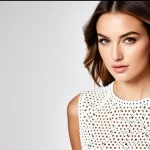Chronological Overview of UK Women’s Fashion Trends
Tracing UK women’s fashion history reveals a fascinating journey through evolving styles. In the early 20th century, the focus was on structured garments with modest hemlines, reflecting societal norms and events like World War I, which prompted practical clothing choices. The 1920s introduced flapper dresses, marking a bold breakaway and celebration of newfound freedoms.
Moving into mid-century, World War II’s rationing influenced minimalist and utility fashion, while the 1960s saw vibrant, youthful looks with mini skirts and bold patterns that echoed cultural shifts. The 1970s embraced eclecticism with bohemian and punk styles reflecting social rebellion.
Also to read : How Can You Ensure Your Wardrobe Reflects the Latest UK Women’s Fashion Trends?
From the 1980s onward, fashion trends by decade showed sharp contrasts—power suits in the 80s symbolized growing women’s workplace presence, and the 90s brought grunge and minimalism influenced by global youth culture. The 2000s and 2010s featured mix-and-match aesthetics and digital-age influences driving rapid style evolution.
Understanding this evolution of style highlights how pivotal events and cultural movements directly shaped UK women’s fashion, creating iconic looks that remain influential today.
In parallel : Finding the Best UK Women’s Fashion Deals Online: Tips and Tricks
Influences Shaping UK Women’s Fashion
The social influences on fashion have been instrumental in shaping UK women’s styles throughout history. Economic factors, such as the austerity during and after the World Wars, directly affected fabric availability, pushing designers to innovate with limited resources. This economic impact on style often resulted in practical yet stylish clothing that balanced necessity with aesthetic appeal.
Cultural icons, including celebrated actresses and musicians, played a pivotal role in popularizing trends. For example, the Beatles’ and Twiggy’s prominence in the 1960s sparked looks that younger generations eagerly adopted. These figures made high fashion more accessible and relatable, influencing the social influences on fashion on a mass scale.
Fashion designers also bridged British and international trends. Pioneers like Mary Quant embraced global influences and, in turn, propagated UK styles abroad. The interaction between British and international fashion scenes continues today, fostering innovation and diverse aesthetics.
In sum, the intersection of social forces, economic realities, and cultural icons has dynamically driven UK women’s fashion. This multifaceted influence explains why social influences on fashion remain a foundational element in understanding style evolution.
Recurring Patterns and Major Shifts in Style
Fashion in the UK demonstrates clear cycles where past trends return with fresh twists. For instance, the 1990s grunge look reemerged in the 2020s, blending vintage edge with modern minimalism. This trend recurrence highlights how designers and consumers revisit classic styles, adapting them for new contexts.
A pivotal shift occurred as women’s wardrobes moved from predominantly formalwear to more casual, versatile garments. This change was partly driven by evolving workplace norms and technology, which altered daily routines. Casual wear no longer signified relaxed time off but became a statement of contemporary lifestyle.
Technological advances and globalization also accelerated these shifts. Fast fashion and online retail introduced rapid diffusion of styles globally, compressing the evolution of style timelines. Cultural exchange enabled diverse influences to merge, making British fashion both eclectic and dynamic.
Understanding these fashion cycles and major shifts offers insight into how UK women’s style continuously reinvents itself while honoring its rich heritage. Observing these patterns lets consumers and designers anticipate and embrace future changes with confidence.
Notable British Designers and Fashion Icons
British designers have played a crucial role in shaping UK women’s fashion history, merging innovation with cultural influence. Icons like Mary Quant revolutionized style with the mini skirt, reflecting youthful rebellion and freedom during the 1960s. This pivotal designer helped democratize fashion, making bold trends accessible to younger generations.
Vivienne Westwood further transformed fashion by introducing punk aesthetics that challenged norms in the 1970s. Her work epitomizes the evolution of style as a form of cultural commentary, blending rebellion with craftsmanship.
In addition to designers, fashion trendsetters like Twiggy embodied the spirit of their time, making impactful statements through personal style and popularizing key looks globally. Contemporary figures continue this legacy, redefining what British fashion means today by integrating global influences with uniquely British sensibilities.
The synergy between fashion trendsetters and British designer influence remains a powerful driver of evolving UK women’s fashion, inspiring new generations to blend heritage and modernity creatively. This dynamic interplay ensures fashion’s continual reinvention, illustrating why the UK remains a style leader internationally.
Historic and Modern Style References
The interplay between classic vs modern trends vividly illustrates how UK women’s fashion bridges past and present. Many iconic elements from vintage eras persist, such as the structured tailoring of the 1940s or the bold prints of the 1960s, inspiring contemporary designers to reinterpret these styles with fresh materials and modern fits.
Historic fashion inspirations serve as a constant reference point, allowing designers and consumers to draw from a rich heritage. This dynamic creates a dialogue between eras—styles like the high-waisted trousers popular in the 1970s have returned with sleek, updated cuts suited to today’s tastes while retaining nostalgic appeal.
Vintage influences are particularly prominent in casual wear and evening attire, where retro aesthetics bring depth and character to modern wardrobes. For example, the resurgence of 90s grunge elements showcases how fashion cycles recycle past looks, evolving them to resonate with current cultural contexts.
Understanding these historic fashion inspirations helps appreciate the continual reinvention that defines UK women’s fashion, blending old and new into innovative, relevant style statements. This fusion ensures the evolution of style remains both respectful of tradition and boldly forward-looking.
Predicting the Future of UK Women’s Fashion
The future trends in UK women’s fashion are increasingly shaped by sustainability in fashion and the growing impact of digital innovation. As environmental concerns intensify, designers and consumers alike prioritize ethical production methods and eco-friendly materials without sacrificing style or quality. This shift signals a significant evolution, where fashion merges responsibility with creativity.
Digital influence on style is another key driver. Virtual fashion shows, AI-driven design, and online personalization enable faster trend adaptation and more interactive consumer experiences. Technology also enhances transparency, allowing buyers to trace the lifecycle of garments—a vital aspect of sustainable choices.
Anticipating future trends involves recognizing these forces together. UK women’s fashion may soon blend cutting-edge tech with classic craftsmanship, creating versatile, durable wardrobes suited for changing lifestyles. This evolution respects the heritage of UK women’s fashion history while boldly advancing into new realms, emphasizing both innovation and values.
Understanding these trajectories helps prepare consumers and designers to embrace a style future that is ethical, adaptive, and distinctly British—an exciting continuation of the evolution of style.







